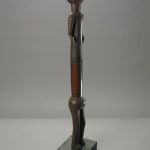Nyamwezi Standing Figure, 1870 CE - 1910 CE
Wood
27.5
PF.9999 (LSO)
Further images
This striking and powerfully-carved figure represents an ancestor, and was made by the artist-craftsmen of the Nyamwezi group. This population, from Central- to North-West Tanzania, number about 500,000 and are...
This striking and powerfully-carved figure represents an ancestor, and was made by the artist-craftsmen of the Nyamwezi group. This population, from Central- to North-West Tanzania, number about 500,000 and are largely agrarian farmers with cultural links to the Sukuma, the Sumbwa, the Kimbu, the Konongo and the Kerebe/Kerewe. Their name is of Swahili origin, and literally means “Men of the West” (or “Men of the Moon”), a moniker they earned in the 19th century from the caravans that used to pass through their territory; they used to call themselves the Wanyamwezi. Their society is highly variable owing to the large area in which they live, but the main themes are consistent: small chiefdoms presided over by paramount chiefs responsible for material wealth, assisted by a sorcerer who takes care of the populace’s spiritual health. Status is inherited, or gained by being a good tracker – especially of elephants.
While they are an aesthetically-inclined people, they do not usually have specifically-appointed artists; such occupations were viewed as additional skills, rather than as socially-valid vocations. However, skilled carvers may well be pressed into providing secular items – notably anthropomorphic thrones and stools – as well as paraphernalia for water divining (elongated stick-figures) traditional religious practices. While they have a detailed pantheon of deities and spirits (including Likube [High God], Limi [the Sun] and Liwelolo [the Universe]) ancestor worship is a more common affair. This takes the form of offerings of animals to one’s predecessors, having first invoked the help of Likube. Witchcraft and possession cults also exist, but are more secretive affairs.
The canons of Nyamwezi art are varied but follow certain tendencies. Most figures are comparatively tall, and made from heavy dark wood that gains a polished appearance from libations or continued handling. They are almost invariably standing, with long torsos, disproportionately short (flexed) legs and slender/nugatory arms. Heads are usually rounded, contrasting with an often angular body. The eyes are usually inlaid with beads, and some figures also have hair and inlaid teeth (a characteristic of Sukuma sculptures and masks). Their sometimes simplistic construction is offset by an ebullience and dynamism that makes the Nyamwezi one of East Africa’s most notable sculpting groups.
This piece is very tall and slender, with short legs and nugatory arms. The upturned face is unusual; the proportions of the figure resemble the famous figures used by the Nyamwezi in water divining. The patina is deep and well-developed throughout. This is a well-presented piece of socially-significant African art.
While they are an aesthetically-inclined people, they do not usually have specifically-appointed artists; such occupations were viewed as additional skills, rather than as socially-valid vocations. However, skilled carvers may well be pressed into providing secular items – notably anthropomorphic thrones and stools – as well as paraphernalia for water divining (elongated stick-figures) traditional religious practices. While they have a detailed pantheon of deities and spirits (including Likube [High God], Limi [the Sun] and Liwelolo [the Universe]) ancestor worship is a more common affair. This takes the form of offerings of animals to one’s predecessors, having first invoked the help of Likube. Witchcraft and possession cults also exist, but are more secretive affairs.
The canons of Nyamwezi art are varied but follow certain tendencies. Most figures are comparatively tall, and made from heavy dark wood that gains a polished appearance from libations or continued handling. They are almost invariably standing, with long torsos, disproportionately short (flexed) legs and slender/nugatory arms. Heads are usually rounded, contrasting with an often angular body. The eyes are usually inlaid with beads, and some figures also have hair and inlaid teeth (a characteristic of Sukuma sculptures and masks). Their sometimes simplistic construction is offset by an ebullience and dynamism that makes the Nyamwezi one of East Africa’s most notable sculpting groups.
This piece is very tall and slender, with short legs and nugatory arms. The upturned face is unusual; the proportions of the figure resemble the famous figures used by the Nyamwezi in water divining. The patina is deep and well-developed throughout. This is a well-presented piece of socially-significant African art.





